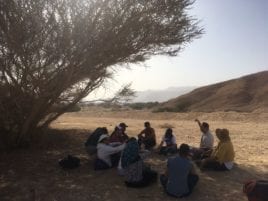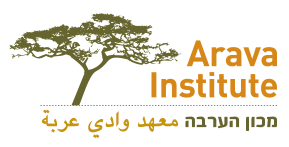
Most of our first day was an astute Dual Narrative tour of Jerusalem with Israeli and Palestinian guides. While Dual Narrative is the term used, in reality it encompasses a multi-narrative approach as no side in this conflict is monolithic in its attitudes, understandings, and opinions. Later that evening we heard two powerful speakers from the Parents Circle; a joint Palestinian Israeli organization of over 600 families, all of whom have lost a close family member as a result of the prolonged conflict. On our second day we visited the Hand in Hand School where Jews and Arabs attend school together – something very unusual in Israeli society. During one of our bus rides I shared the following teaching to help frame some of what we had heard as well as give a further understanding of the work and mission of the Arava Institute.
[box]We read in the Book of Genesis that Abraham and Sarah have difficulty conceiving, and so Sarah gives her handmaiden Hagar to Abraham. From that union, Hagar becomes pregnant. Sarah’s response is jealousy and so she throws the pregnant Hagar out into the desert. There by a spring, the grief-stricken and frightened Hagar is spoken to by an angel. We note that not only is it the first time in the Bible an angel speaks to a human, but that the first time an angel speaks to a human, it is to a woman and not a man, and that the angel speaks not to a Jew, or a Christian, or a Muslim, but to a pagan.
At that encounter the angel tells Hagar to go back to the tent of Abraham and Sarah and that she should name her son Ishmael, meaning “God has heard.” Hagar is so overwhelmed by the encounter that she calls the spring Beer-lahai-roi, “Well of the Living One Who Sees Me.” That will not be the last time we will hear of this water source. Many years later Isaac will be born to Sarah and Abraham and once again Hagar and Ishmael will be expelled from the camp. A seemingly heartless act that we will circle back to shortly.
Isaac grows up and one afternoon, while he is near the spring of Beer-lahai-roi, he meditates. When he is done meditating he looks up and sees his wife Rebekah for the first time. Shortly after we read that Abraham marries a woman named Ketura; Sarah having died years earlier. Her name is the same name as the kibbutz where the Arava Institute is located.
The spring Beer-lahai-roi is mentioned for a third time after Isaac and Ishmael come together to bury their father Abraham, next to Sarah, in the Cave of Machpelah in Hebron. After the funeral, we are told that Isaac returns to the spring of Beer-lahai-roi.
The story of Hagar, Sarah, and Abraham is unsettling at best and raises many difficult questions about the actions of Abraham and Sarah. How could the matriarch and patriarch of the Jewish people have acted in such a way? Moreover, when we overlay the story with the understanding that the Jews are the descendants of Issac, and the Arabs are the descendants of Ishmael, the story takes on a political overtone with a disquieting element.
While we may understand those questions to be contemporary, coming from our 21st century sensibilities, we discover that our questions and concerns are not so new. The rabbis reading and wrestling with the text some fifteen hundred years ago were also disturbed by what they read. In that encounter with the text they creates a slightly different scenario anchored at the spring of Beer-lahai-roi.
They were intrigued by Abraham’s second wife, Ketura, and her name. The rabbis noted that the name Ketura is related to the word keturet, meaning incense. They noted that Ketura must have been a woman who used incense and, therefore, must have been a pagan. What woman would Abraham have known who was a pagan?, they asked. Hagar! The rabbis understood Ketura to be another name for Hagar. They built further on that reading of the text by the multiple use of the spring of Beer-lahai-roi by Hagar, Ishmael, and Isaac. They created meetings between Abraham and Ishmael during the ensuing years, and, by extension, between Abraham, Isaac, Hagar, and Ishmael. Ishmael and Isaac coming together to bury their father, as we read in the text, then does not appear so surprising.[/box]
Thus, the rabbis made a repair, a tikun, of the text, which in this case allows for a different relationship to emerge between Abraham, Isaac, Hagar, and Ishmael than what appears on the surface of the text. This is exactly the work we do at the Arava Institute on a kibbutz named Ketura (Hagar): repair relationships between Jews and Arabs, as we also repair our shared environment and home together.
Rabbi Michael Cohen teaches conflict resolution at Bennington College’s Center for the Advancement of Public Action (CAPA). He is one of the founding faculty members of the Arava Institute and continues to support its work from near and far. During the Fall 2016 semester, which he is spending in Kibbutz Ketura with his wife Alison, he is teaching the course “The Bible as a Key to Environmental Thought”, and blogging regular reflections on the Arava Institute and its surroundings.

